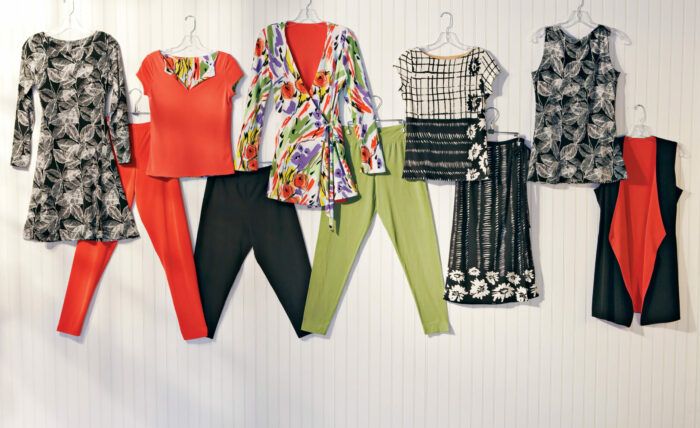
There’s a moment every summer when a garden suddenly rewards springtime effort. Planting and planning render beautiful results.
In a sense, I think the same is true for sewing. By putting simple effort into a wardrobe concept, you can reap truly wearable clothes. When you sew garments that coordinate, it pays off in more outfits for less sewing time. It also means you have polished, put-together looks.
By taking this approach to your summer sewing, you’ll achieve very wearable clothes for this easy season.
Consider cost, time, and purpose
Here is some practical advice to help you with costs and planning. I’ve found that establishing some parameters pays off during the design possibilities phase.
Set a budget
It is important to bring the elements all together and have them on hand from the start. You’ll have upfront costs for fabrics, patterns, and notions. I used five patterns and six fabrics for this collection, with thread as the basic notion. Great fabric should be a priority. Consider fabrics already in your stash that you can incorporate into the collection. Watch favorite sources for sales and specials.
Keep on track
Set a deadline, and decide how much time you have to devote to the collection. How many hours/days do you have to complete the work? Make a calendar of possible times you can sew, and try to stick with it. I suggest allowing yourself at least four weeks to complete a wardrobe group.
Define the collection
Your wardrobe’s function influences your costs and time commitment. Are you willing to invest more in a professional collection, or is this a casual, fun wardrobe for the season ahead? Take into account your everyday clothing choices: lifestyle, climate, hobbies, and work. This method can be applied for other seasons and situations. One collection won’t cover all your clothing needs, but a wardrobe approach can work for different aspects of your life.
3 reasons to sew a wardrobe
You can always sew single garments you love, but applying a collection concept to sewing has great benefits. Here are just a few:
Enhance what already works
Once you have chosen patterns and test-fit sample garments, it’s easy to apply design details and simple changes to enhance the clothes’ look and wearability. You won’t have to fit again, and additional garments increase the potential outfit combinations.
Stay motivated
Sewing a collection allows you to work on whatever you are in the mood for at a particular time: pattern work, serging, sewing, pressing, detailing, fitting, or hand sewing.
Spend less per outfit
In my experience, for a budget just under $400, you can make nine to twelve garments. Considering that coordinating fabrics and planning combinations easily yield more than twenty outfits, the cost per outfit is less than $20.
Develop a wardrobe concept
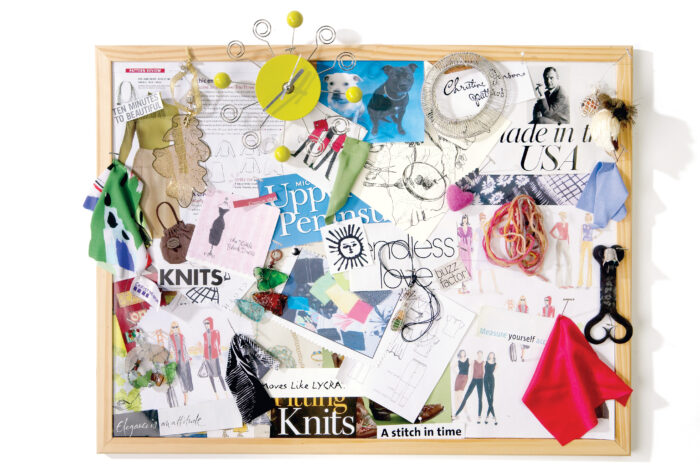
Though it may sound counter-intuitive, I believe creativity begins with planning. Think about the clothes as an interdependent group; collect inspiration from magazines, fabric suppliers, your own closet, and more to develop a working style.
A storyboard gives you a view of your ideas and collection concept that you won’t see
any other way. It is a means for you to gather and display your inspirations, a place to collect your thoughts and arrange information about your collection.
Storyboards can include anything that is common to your theme. I suggest you purchase a large cork bulletin board. Hang it on a wall or lean it up against a table, but view it at eye level. You’ll be surprised at what jumps out at you as you walk past.
Include fabric swatches, fashion illustrations, fashion show photos, paint color chips, flowers, sketches, cut-out letters and words, notes, shapes, your own photos, fabric and sewing swatches, thread and yarn, color combinations, outfit possibilities, buttons, and more. Add anything that inspires you.
As the storyboard develops a vibe and direction, your personality begins to show through it. The assembled colors, shapes, and ideas contribute to making your collection unique.
Learn from what works
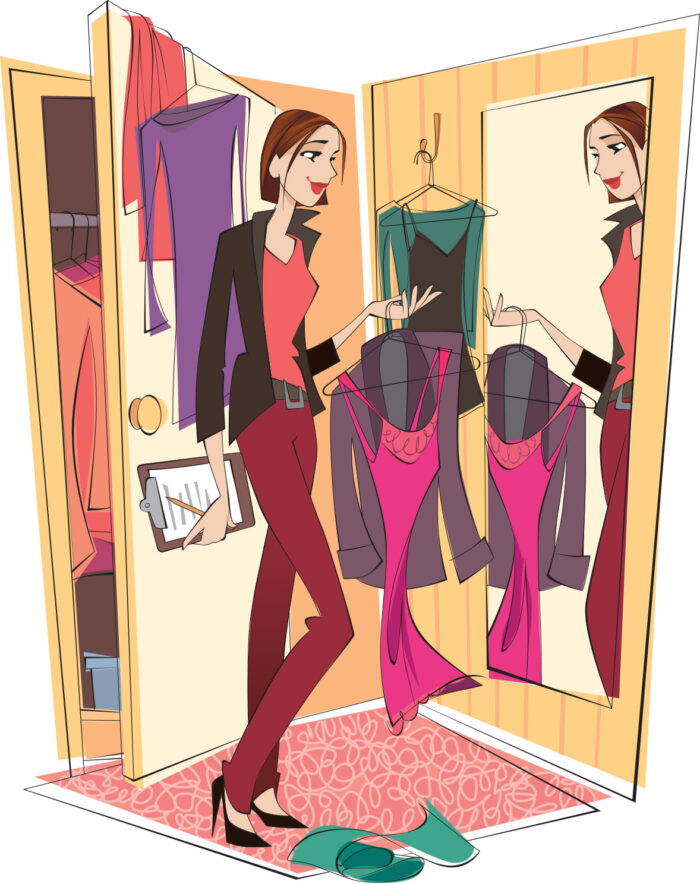 The clothes and fabrics you rely on are another planning tool.
The clothes and fabrics you rely on are another planning tool.
Explore your closet
Try on clothes that are in your closet, and critique them. What are your favorite designs and why? Jot down what you like and dislike about the fit, fabric, and colors. Use this information to edit garments, fabrics, or details that don’t meet your wearability criteria.
Take cues from favored fabrics
As a clothing designer and patternmaker, I have to say fabric usually controls a collection’s direction for me.
Your fabric mindset for a summer wardrobe is: Don’t settle for any fabric that you don’t love. No filler pieces! This ensures that when you go to your closet to find the perfect outfit to suit your mood/day/event, it’s there. Choose fabrics that you would be excited to wear.
For summer sewing, I suggest choosing fabrics that are easy to handle. Imagine laying out the fabric, cutting it, moving it around, serging and sewing it. If it seems as if it is difficult to work with, move on. Stay away from slippery, slinky-type fabrics as well as unstable weaves, knits without spandex, and fabrics without personality.
Don’t feel you must work with solid fabrics and a monochromatic color scheme to achieve a versatile wardrobe. I consider the appeal of a print, the pop of mixed colors, when I make fabric selections. The priority is that you create garments you love to wear. Another factor in wearability is ease of care. All of the fabrics I used in the sample collection pictured on these pages were knits in a blend of synthetics and natural fibers. There’s no need to iron or dry-clean the garments—just put them on and go.
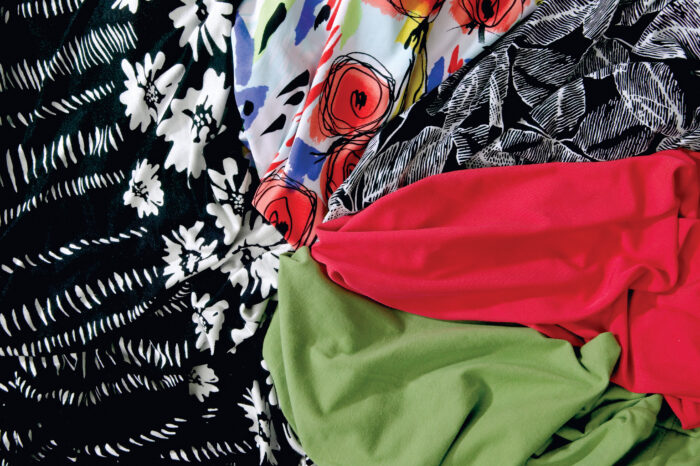
Make maximum outfits with minimum effort
Summer clothing calls for simplicity, not mediocrity. Test your wardrobe patterns’ fit, style, and redesign potential.
Look for essential pattern elements
In choosing the patterns for this summer collection, I looked for interesting and diverse design lines, self-lined/reversible options, and simple redesign possibilities. Your priorities (look at your storyboard, and reexamine your collection concept) guide your choices.
Always examine a pattern’s technical line drawing to assess its potential. Fashion illustrations and ready-made garment photos can be deceiving.
After reviewing each pattern, list all the design options that you can come up with for it. Read and think about the information included with the pattern.
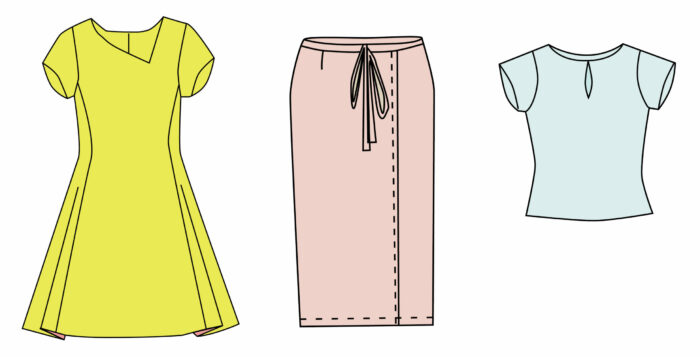
Make a design record
Keep a notebook with your measurements, what size pattern you used, how you altered the sample, and what additional changes you may want to make to the pattern.
What design ideas do you have? Draw some simple sketches to keep ideas in mind. Write your thoughts, design lines, and notes on sample garments. Then keep them for future reference.
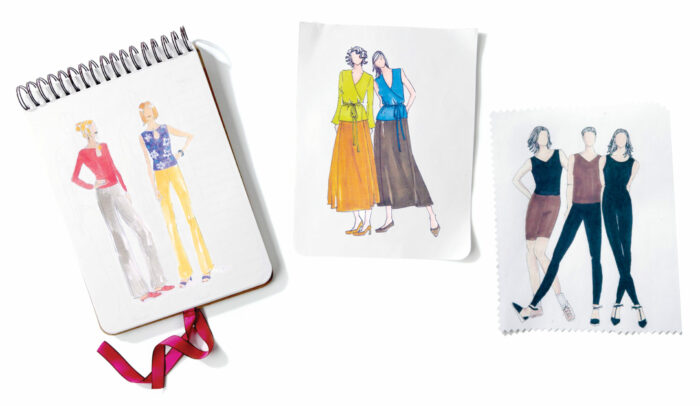
Create sample garments
Quick sample garments from the patterns offer tons of information to guide your wardrobe’s direction. I purchase 5 to 10 yards of inexpensive knit and woven fabric to make samples.
Cut the samples with additional length in the size closest to your body measurements. Choose the smaller size if you are between sizes. Only use the necessary pattern pieces to test for fit.
Once the basic pattern has been fit to your body with the desired ease, shape, and minimum length, transfer the changes to your pattern, or trace off a new pattern. You can now use this pattern to redesign details without worrying that the garment won’t fit. Just don’t make any changes to the basic fit.
Go ahead and have fun! Use the sample garments to test design details, such as narrow tucks at a hem, neckline changes, or sleeve shapes and lengths. Details that cannot be added after a garment has been cut need to be worked out at this stage.
Streamline your wardrobe sewing
A summer collection can be constructed production-style. Here are a few suggestions to help you create quickly and efficiently.
- Post an illustration of each garment on your storyboard. Pin swatches of the fabrics you’ll be using for each one under the illustrations. As you cut out each pattern, remove it from the board. This helps you track progress.
- Decide if you can speed up the cutting by layering the fabrics or laying out more than one pattern at a time on a particular fabric. Bundle and keep the cut pieces for each garment together.
- Designate a number for each garment, and mark it on each pattern piece’s wrong side.
- Fuse all interfacing in place at the same time. Make all the collars, bands, facings, etc. at the same time.
- Moving from one garment to another, serge or sew as much as you can prior to a first fitting, if necessary.
Build a cohesive collection
This quick wardrobe collection includes a dress, wrap jacket, top, skirt, and pants with length options. I’ll explain what makes these pieces good wardrobe options and their redesign potential. In coordinating fabrics, these simple garments can result in more than 25 outfits.
Princess-seam dress
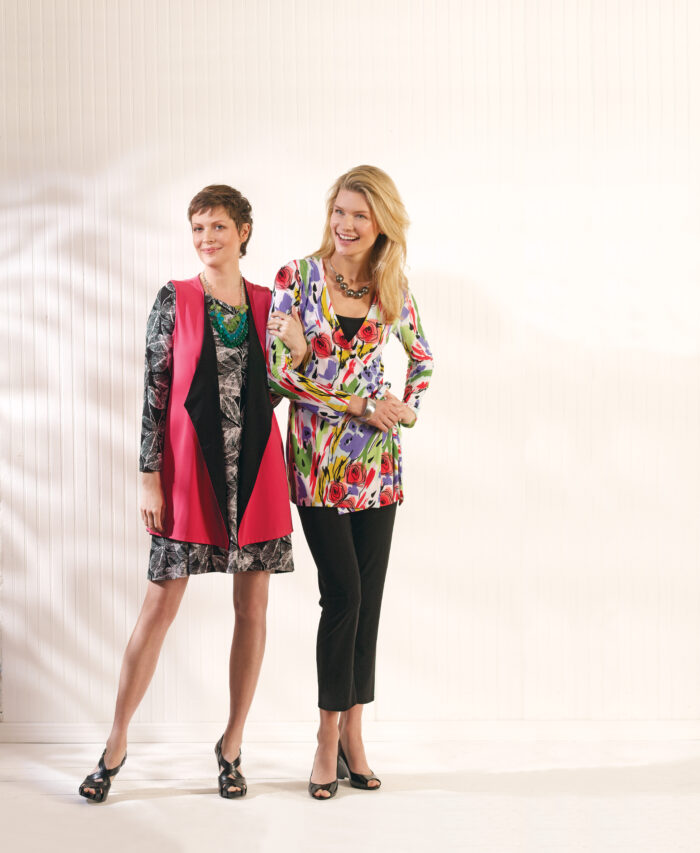
This easy-to-fit dress has a self-lined bodice. Pattern changes include sleeveless or sleeve variations, or shortening it to a top. You can mix in coordinating fabrics at the side seam panels (also a slimming, figure-enhancement trick).
Sleeveless Reversible Wrap
The long vertical lines of a vest offer an instant visual slimming effect. This version flips from coral to black for versatility. You can cross the “lapels” over each other and belt and blouse the vest for another look.
Bell-Sleeve Wrap
A versatile jacket is a great piece in a wardrobe collection. It layers over other garments to create outfits and has great redesign potential. This wrap jacket is shown in a sleeveless, reversible vest version at left. Shorten the jacket for a shrug. The pattern works in knit or woven fabrics; just use a larger size for wovens.
Slim-fit pants
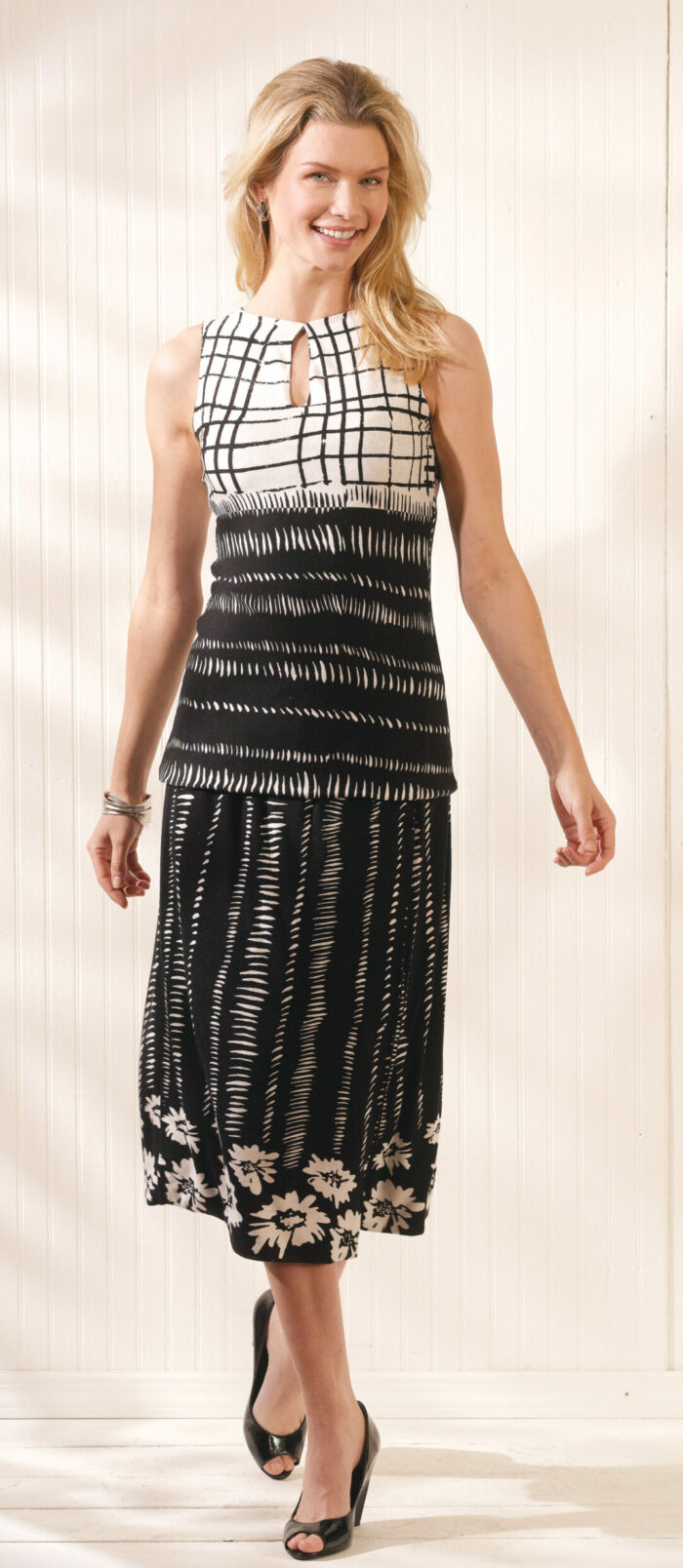
These knit bottoms have leggings’ simplicity, but a lot more ease. For roomier, tapered-leg pants, go up two to three sizes. The waist can be made with wide or narrow elastic or with a stretch-fabric band.
Keyhole top
The keyhole is a nifty detail, but this self-lined shirt becomes a flattering boat neck without it, too. In a sleeveless version, the top is reversible. My favorite variations include changing the sleeve length and ruching the side seams.
Wrap skirt
A deep underwrap makes this comfortable skirt’s fit adjustable. Its straight hem is easy to alter—everyone has a skirt length that looks great on them. Make it in a single layer, or use two fabrics in a reversible version. It can be sewn in knit or woven fabrics.
Christine Jonson is a patternmaker and clothing designer. To learn more about her designs, visit CJPatterns.com.






Log in or create an account to post a comment.
Sign up Log in